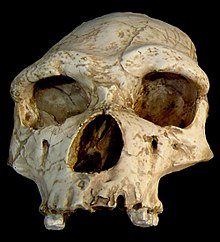
Back Tautavelmens Afrikaans إنسان تاوتافيل Arabic Home de Talteüll Catalan Mensch von Tautavel German Hombre de Tautavel Spanish Homme de Tautavel French Uomo di Tautavel Italian Tautavelmens Dutch Tautavelmennesket NB Òme de Talteüll Occitan
| Tautavel Man Temporal range:
| |
|---|---|

| |
| Reconstructed face of Arago 21 | |
| Scientific classification | |
| Domain: | Eukaryota |
| Kingdom: | Animalia |
| Phylum: | Chordata |
| Class: | Mammalia |
| Order: | Primates |
| Suborder: | Haplorhini |
| Infraorder: | Simiiformes |
| Family: | Hominidae |
| Subfamily: | Homininae |
| Tribe: | Hominini |
| Genus: | Homo |
| Species: | |
| Subspecies: | †H. e. tautavelensis
|
| Trinomial name | |
| †Homo erectus tautavelensis de Lumley and de Lumley, 1979
| |

| |
| Site of discovery in Tautavel, France | |
Tautavel Man refers to the archaic humans which—from approximately 550,000 to 400,000 years ago—inhabited the Caune de l’Arago, a limestone cave in Tautavel, France. They are generally grouped as part of a long and highly variable lineage of transitional morphs which inhabited the Middle Pleistocene of Europe, and would eventually evolve into the Neanderthals (Homo neanderthalensis or H. sapiens neanderthalensis). They have been variably assigned to either H. (s.?) heidelbergensis, or as a European subspecies of H. erectus as H. e. tautavelensis. The skull is reconstructed based on the specimens Arago 21 and 47 (probably male), and it is, to a degree, more characteristic of what might be considered a typical H. erectus (sensu stricto) morphology than a typical H. heidelbergensis morphology. The brain capacity is 1,166 cc. They seem to have had an overall robust skeleton. Average height may have been 166 cm (5 ft 5 in).
The Caune de l'Arago opens on a cliffside 80 m (260 ft) above a river, overlooking the Tautavel plain, with a plateau above, and mountainous terrain to the sides. During and after human occupation, the area swung from temperate and humid forestland, to cold and dry steppeland. Stratigraphically, humans are present from beds Q–C. Bed G, dating to roughly 455,000 years old during a forested event, has yielded the most remains. They seem to have hunted a variety of animals, including red deer, fallow deer, argali, tahr, horse, reindeer, beaver, and more. They made Acheulean stone tools, but mainly produced smaller retouched tools such as scrapers, rather than more iconic macro-tools such as bifaces (hand axes). In beds G and F, they may have been practicing ritual cannibalism. Evidence of fire is absent until bed C (400,000 years ago).
© MMXXIII Rich X Search. We shall prevail. All rights reserved. Rich X Search